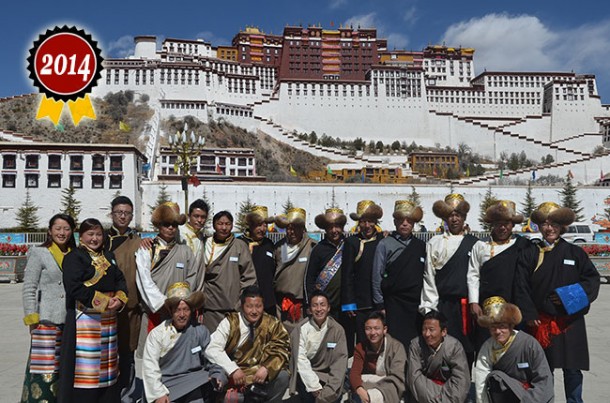Potala Palace-Lhasa,Tibet.

Songtsen Gampo was the first Tibetan ruler to establish a palace on this outcrop, the red hill which dominates the city of Lhasa, Old pictures of the Potala often show a tall stone stele rising up from the ground in front of the potala. Now it was stands on the opposite site of the main road by the Potala. This is the ancient Zhol pillar,erected about 764 by the loyal minister and general of Trisong Detsen, Ngenlam Tagdra Lugong.Construction of the present Palace began in earnest in 1645 during the reign of the great fifth Dalai Lama. BY 1648 the white Palace was completed. To finished the rest of the building , known as the Red palace, his chief advisor, Desi Sangye Gyatso, had to conceal the Dalai Lama’s death and pretend that he was in a prolong retreat. The red palace was completed in 1694, twelve years after the Dalai Lama’s death.The building is named after Mount Potala in South India,one of the Holy mountains of the Hindu god Shiva. Buddhist, However,dedicated this same mountain to Avalokiteshvara, the boddhistattva of compassion and gave the name “Potala” to the pure land where Avalokiteshvara resides. Since both Songtsen Gampo and the Dalai Lama were considered to be incarnations of Avalokiteshvara, Potala was the obvious name for their dwelling.The Potala has served as the home of the successive Dalai Lama and their monastery staff from the time the fifth until that of the present Dalai Lama. From the latter half of the eighteenth century it has been used as the winter palace and the Norbulingka as the Palace where the rulers would retreat during the summer months. With the exception of a section added on to house the tomb of the Thirteenth Dalai Lama, the palace is much the same as when it was first built. Now a days Potala is one of the most well-known historical spot. Lhasa is highlighted by the beauty of the Potala and its a landmark that is impossible to miss. It is located at the west of the city and is reached simply by the following the Dekyi Shar Lam western from the old city.The first impression you may have of the Potala is that it is not located at the great height that most photographs suggest. Compared to the surrounding mountains, the rocky outcrop on which it stands is tiny. Nevertheless, as you slowly acquaint yourself with the dimensions and proportions of this incredible building, the awesome grandeur of its architecture becomes so much more tangible and real that even the most rapturous description seems inadequate.
Recent Posts
Traveling to Tibet from China by Train
How to plan a trip to Tibet?
Top 5 Most Asked questions on Tibet Travel
All Categories
- About Tibet
- book a Tibet tour
- Buddhism Practice
- Budget Tour
- China-Tibet Train
- Customized Tibet tour
- Historical Sites
- Hot Springs in Tibet
- News
- Photography in Tibet
- Tibet attraction
- Tibet Group Visa
- Tibet Motorcycle Tour
- Tibet Small Group Tours
- Tibet Tours and Tibetan Tour Guide
- Tibet Train
- Tibet Travel FAQs
- Tibet Travel Information
- Tibet Travel News
- Tibet Travel Permit Update
- Tibet Travel Prices Rises
- Tibet Trek
- Tibet Trekking Tour
- Tibet weather and climate
- Tibet Wildlife animals
- Tibet Winter Tour
- Tibetan Buddhism
- Tibetan Cultural Features
- Tibetan Culture and Poeple
- Tibetan Festivals
- What to see in Tibet



